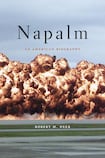
"Napalm, son – nothing else in the world smells like that. I love the smell of napalm in the morning." In a quote from the Vietnam war movie Apocalypse Now Lieut Bill Kilgore, played by Robert Duvall, extols his love of the chemical weapon napalm. In this history of the development of napalm Robert M Neer incorporates the iconic cinematic reference to the infamous gel incendiary in a thorough analysis of the weapon's fall from grace in the eyes of the American public.
Neer is a lawyer and lecturer in the history department at Columbia University, in New York. His book provides us with a meticulous account of the development of napalm as a chemical weapon that would eventually be responsible for the deaths of millions of innocent civilians around the world. At a time of increasing paranoia about weapons of mass destruction in general and chemical weapons in particular, Napalm is a timely contemplation of the political, economic and sociological factors that combined to produce such a seemingly simple yet diabolical munition.
The story of napalm began at Harvard University in 1940. In what Neer describes as the creation of the military-academic complex, President Roosevelt established the National Defence Research Committee to develop new weapons of war for use against the rising threat of international fascism in Europe and Japanese expansion in the Pacific. The committee would revolutionise the relationship between the US federal government, corporations and the academic elite. Under its direction and funding, US universities were to become “fully integrated into the US war effort”. The academy was to become an engine of “absolute” warfare.
At Harvard Louis Fieser, a professor of organic chemistry, received funding to develop a "sticky" incendiary gel that would burn enemy targets and industrial infrastructure. Fieser's Anonymous Research Project #4 quickly produced results. Combining aluminium napthenate and aluminium palminate with petroleum products and white phosphorous, Fieser produced napalm. Mixing the ingredients with a meat grinder taken from the Harvard dining hall, he produced his first viable napalm device on Independence Day 1942. He and his graduate students detonated the incendiary on soccer fields next to the Harvard football stadium. "Fieser flipped a switch . . . A spectacular billowing 2,100-degree-Fahrenheit fire cloud rose over the field . . . Tennis players scattered."
The following year the US military deployed 250,000kg of Fieser’s napalm at enemy targets. The military-industrial complex ramped up production of this new and potentially militarily decisive weapon. By 1944 millions of kilos of napalm were being detonated against military targets in Normandy during the D-Day landings. Millions more were deployed in close support of the Allied advance on Germany.
In Asia, however, Neer notes a variation in the targeting and deployment strategy for napalm. In 1945 more than six million kilos were dropped on "area", or civilian, targets in Japan. The US military targeted the cities of Tokyo, Nagoya and Osaka and their civilian populations for annihilation.
In the Tokyo attack, on the night of March 9th, 1945, four-year-old Kiichi Morikawa witnessed the deaths of his eight-month-old twin sisters, burned alive by napalm. His mother held his hand as he too burned to death. As the flames intensified, impossible to extinguish, he cried out to her: “Mother, it’s hot.” Shivering, he died in convulsions. His last word was “Mama”.
Neer cites and quotes several sources that acknowledge napalm was a terror weapon. One US pilot, commenting on its psychological effect, observed: “People have this thing about being burned to death.”
Anonymous Research Project #4 cost $5.2 million. Napalm destroyed 275sq km of Japan’s top six population centres in horrific firestorms in 1945. About 333,000 innocent men, women and children were burned alive.
In contrast, the Manhattan Project cost the US taxpayer $27 billion. In a horrific cost-benefit comparison, the atomic bombs at Nagasaki and Hiroshima destroyed a mere 13sq km of residential population centre between them. According to Neer, the US authorities regarded napalm, as a killer of civilians, as about 5,000 times more cost effective per head than atomic weapons.
Neer’s chilling account of this indiscriminate weapon of mass destruction begins and ends with quotes from child victims of napalm. After-action reports and eyewitness accounts over the years have shown that children typically form a disproportionately large cohort of napalm casualties. The book opens with an interview with Kim Phúc, the nine-year-old girl who was photographed running from her village in a napalm attack in 1972. The photograph, which features Kim running naked towards the camera with horrific burns, is silent testimony to the meaning of napalm.
In Neer’s prologue, Kim Phúc describes the day she and her family were burned. She describes how her hands, arms and back were burned by the gel. She describes how it burned her beautiful hair – her precious ponytail – and seared her scalp and neck. With her clothes burned from her body, and with parts of her still alight, she could only manage to cry for her mother. “Oh, Ma, it’s too hot. Too hot.”
At the end of Neer’s book Kim Phúc describes the hatred of the US that consumed her, as she recovered from her wounds, as “another napalm within me”. Ultimately, though, she decided that “love was her only solution” and that her survival – physical, psychological and emotional – came through forgiveness. “Faith and forgiveness are much more powerful than napalm could ever be.”
In 1980 the UN declared the use of napalm against civilian targets a war crime; in 2011 the US finally endorsed that view and joined the global consensus on the weapon.
Tom Clonan is a security analyst. He is a retired army officer with experience in the Middle East and former Yugoslavia, and is the author of Blood, Sweat and Tears, a memoir of military service, murder and mayhem in Lebanon. He lectures in the school of media, Dublin Institute of Technology.












